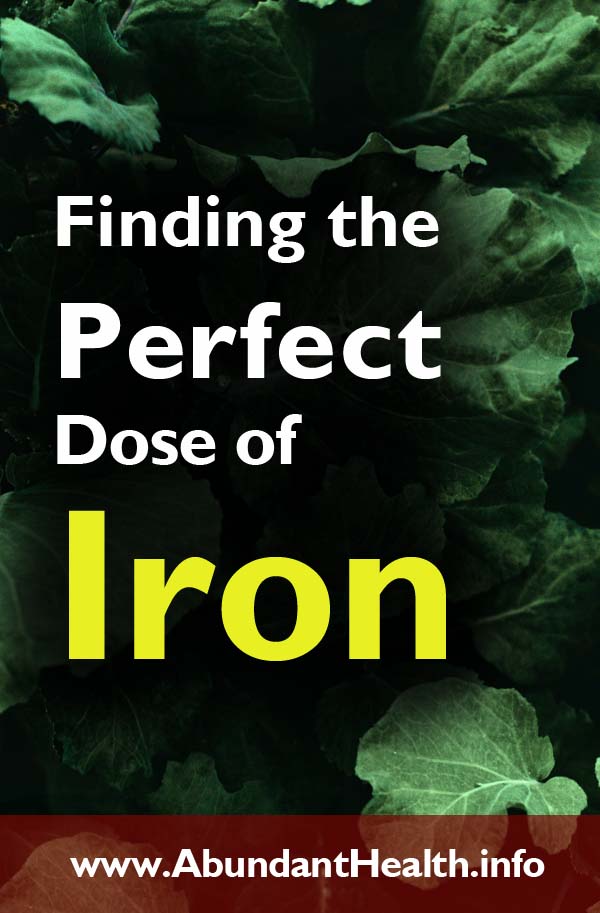Globally, between one and two billion people in both developed and developing countries suffer from iron deficiency. It is the most frequently observed nutritional deficiency. Even so should iron supplementation be administered with caution, because an iron overload has its own problems. The healthy body protects itself for a long time from being overloaded with iron by means of various mechanisms. But unfortunately, this mechanism doesn’t work for some people. They suffer from haemochromatosis, the iron storage disease.

Iron Inside the Organism
The primary role of iron is the binding of oxygen to hemoglobin in red blood cells. It transports the oxygen from the alveoli via the blood vessels to the body cells. On the way back, the hemoglobin takes the carbon dioxide formed in the cells with it into the lungs, where it is excreted with the breath.
But iron has yet many other tasks. It helps the immune system fight pathogens. Experiments have shown that both an iron deficiency and an excess hinder the body’s phagocytes in their task of rendering bacterial pathogens harmless.

Iron is also a component of many enzymes, which in turn perform a wide variety of tasks in the body. They help to ward off oxygen from producing free radicals, they transfer electrons during energy production, and they help to produce bile acids and hormones.
The total iron stock of a 170lbs (75 kg) man is about 4 g, a 120lbs (55 kg) woman about 2.1 g. A little more than two thirds of it is bound to hemoglobin, around a quarter is bound to ferritin, the iron store, and a small remainder is still found in myoglobin, the red muscle pigment.
Iron is stored in the liver, the spleen, the bone marrow and the intestinal mucosa. The amount of iron in the blood plasma is around 3 – 4 mg and is subject to daily fluctuations.
Iron Requirements
The organism’s iron requirement is very low. The body is very economical with its iron reserves. Iron can only be excreted with difficulty through the intestines, urine, bile and sweat. Larger amounts are lost only when bleeding. That is why women need more iron than men up to menopause. Pregnant and breastfeeding women also need more iron, but will have savings by the absence of the period during pregnancy. Growing children have higher requirements. Children need about 8 mg per day, adolescent men 12 mg, female adolescents and women up to menopause 15 mg, after that about 10 mg as do men.
Which Foods are Rich in Iron?
Meat, cereals and leafy vegetables are the main contributors to the iron supply. Iron from meat is more easily absorbed by the body than iron from a plant-based diet. In the plant, iron is mostly present in poorly soluble compounds. But the simultaneous presence of vitamin C remedies this deficiency. Experiments have shown that vitamin C can increase the uptake of iron from the plant up to seven times. This is why vegetarians can still get enough iron. They usually have a higher consumption of vitamin C than meat-eaters. An increased intake of vitamin C has a better effect on iron absorption than additional iron intake, whether through diet or iron supplements.

Good plant sources of iron include lentils, chickpeas, beans, tofu, cashew nuts, chia seeds, ground flaxseed, dark green leafy vegetables, dried apricots and figs, raisins, and quinoa.
Iron Deficiency
A deficiency arises when the intake via the diet is too low, the absorption is disturbed, there is an increased need or there is a loss of iron through bleeding. Iron deficiency is the most common nutritional deficiency worldwide. It is caused by an deficient diet in poverty, or avoidance of nutritious foods in affluent countries. However, some food ingredients can also hinder iron absorption. Particularly widespread is the iron deficiency in areas where a lot of black tea is consumed, because it contains a high amount of tannin, which hinders the absorption of iron. Parasites in the digestive tract also lead to deficiency symptoms as they cause a higher blood loss.
A deficiency can also be caused by certain diseases such as rheumatism, cancer, hormonal disorders, infections or by drugs such as antibiotics or painkillers.
Symptoms of iron deficiency include fatigue, decline in performance, weather sensitivity, grooves in the nails, cracks in the corners of the mouth, dry skin, shortness of breath, and palpitations on exertion.
The clinical picture is hypochromic, microcytic anemia. Caused by a lack of iron and thus also a lack of hemoglobin, there is a deficiency in red blood cells. In turn, less oxygen can be transported. The whole oxygen-dependent metabolism is impaired.

People who suffer from iron deficiency should first find out the reason. Is it due to insufficient intake or absorption? Chronic blood loss must also be eliminated. This is done by testing for hidden blood in the stool. Self-prescribed use of iron-containing drugs or preparations is not recommended. They should only be taken under medical supervision. If the iron stores are filled, further iron absorption can be dangerous. Iron overload can lead to many negative effects such as joint pain, diabetes, heart problems, hormonal imbalances, impotence, cirrhosis of the liver, and liver cancer. The resulting pathology is called hemochromatosis, or iron storage disease.
Iron Overload
Hemochromatosis is one of the most common genetic disorders in the United States, affecting about 1 million people. It most often affects people of European descent. It is caused by increased iron absorption by the intestines. This leads to deposits in various organs and to considerable damage. The total iron content in the body is increased by up to 80 g. In lab tests this can be proven by a very high transferrin saturation. Without therapy, the disease leads to a significant reduction in quality of life and longevity. In this hereditary disease, the damaged gene is not on a sex chromosome. If the damage is to only one chromosome, the carrier will not become ill. For the offspring to fall ill, both parents must be carriers of the trait. Men get sick much more often than women. The disease does not manifest itself before the age of 20, usually between 40 and 60. In women only after the menopause, as the menstrual period causes iron loss. This brings us to the only sensible treatment: it is bloodletting, with the technical term phlebotomy. Initially, about 500 ml of blood is drawn from the patient once or twice a week. The intervals are reduced later. About 200 mg of iron can be removed with each bloodletting. Unfortunately, the patients are not qualifying as blood donors because their blood does not correspond to the normal values. A low iron diet will not cure the disease. However, it is advisable to avoid foods that are very iron-rich, such as offal, oysters and clams. With timely diagnosis and therapy, quality of life and lifespan are not restricted. If treatment does not take place, about 70% develop diabetes and many develop cirrhosis of the liver.
Summary
To avoid iron deficiency, you should pay attention to the increased consumption of fruits and vegetables containing vitamin C. This allows iron to be better absorbed. Additional iron supplements should only be taken under medical supervision, as the limit to the toxic dose can be exceeded very easily.

Stay Always Up to Date
Sign up to our newsletter and stay always informed with news and tips around your health.

Esther Neumann studied Nutrition at the University of Vienna. Since then she served as an author for the health magazine “Leben und Gesundheit” and conducted health lectures in various locations of Austria.
Very informative. Timely and on point.
Just the information need for this time.
excellent information very well presented
Thank you My the Lord Jesus bless you
do keep giving he helpful health information
Very valuable indeed